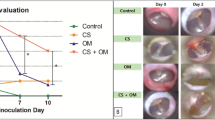Abstract
The rat is commonly employed in otological research, but spontaneous ear infections can confound the results of experimental procedures—wasting time, money, and animals. The authors focus on the incidence of spontaneous otitis media in Wistar rats. They compare disease incidence in animals housed in standard cages with those housed in barrier units, showing that 20% of their conventionally housed animals developed spontaneous otitis media, whereas only 5% of their animals housed in isolated units were infected. These results underscore the importance of strict control of the shipping, housing conditions, and manipulation of animals to be used in otological research.
This is a preview of subscription content, access via your institution
Access options
Subscribe to this journal
We are sorry, but there is no personal subscription option available for your country.
Buy this article
- Purchase on Springer Link
- Instant access to full article PDF
Prices may be subject to local taxes which are calculated during checkout



Similar content being viewed by others
References
Grote, J.J. & van Blitterswijk, C.A. Acute otitis media. An animal experimental study. Acta Otolaryngol. 98(3–4), 239–249 (1984).
Henry, K.R., McGinn, M.D., Carter, L.A. & Savoska, E.A. Auditory brainstem function of the F1 offspring of the cross of CBA/CaJ and AU/SsJ inbred mice. Audiology 31(4), 190–195 (1992).
Henry, K.R. & McGinn, M.D. The mouse as a model for human audition. A review of the literature. Audiology 31(4), 181–189 (1992).
Trinidad, A., Ramírez-Camacho, R., García-Berrocal, J.R., Verdaguer, J.M. & Daza, R. Labyrinthitis secondary to experimental otitis media. Am. J. Otolaryngol. 26(4), 226–229 (2005).
Trinidad, A. et al. Pseudomonas aeruginosa infection in the hypoventilated middle ear: an experimental model. Acta Otolaryngol. 125(3), 266–269 (2005).
McGinn, M.D., Bean-Knudsen, D. & Ermel, R.W. Incidence of otitis media in CBA/J and CBA/CaJ mice. Hear. Res. 59(1), 1–6 (1992).
Meek, R.B., 3rd, et al. Immunologic and histologic observations in reovirus-induced otitis media in the mouse. Ann. Otol. Rhinol. Laryngol. 108(1), 31–38 (1999).
Stewart, D.D. & Buck, G.E. The occurrence of Mycoplasma arthritidis in the throat and middle ear of rats with chronic respiratory disease. Lab Anim Sci. 25(6), 769–773 (1975).
Wullenweber, M., Jonas, C. & Kunstyr, I. Streptobacillus moniliformis isolated from otitis media of conventionally kept laboratory rats. J. Exp. Anim. Sci. 35(1), 49–57 (1992).
Pass, D. & Freeth, G. The rat. ANZCCART News 6(4), 1–4 (1993).
Baker, H.J., Lindsey, J.R. & Weisbroth, S.H. The Laboratory Rat. Biology and Diseases (Academic Press, New York, 1979).
Institute for Laboratory Animal Research, National Research Council. Guide for the Care and Use of Laboratory Animals (National Academies Press, Washington, DC, 1996).
Percy, D.H. & Barthold, S.W. Pathology of Laboratory Rodents and Rabbits (Iowa State University Press, Ames, IA, 2001).
Siegel S. in Non-Parametric Statistics for the Behavioral Sciences 1st edn. (ed. Siegel, S.) 84–120 (McGraw-Hill, New York, 1956).
Keleman, G. in Pathology of Laboratory Animals Vol. 1 (eds. Benirschke, K., Garner, F.M. & Jones, T.J.) 620–640 (Springer-Verlag, New York, 1978).
Eamens, G.J. Bacterial and mycoplasmal flora of the middle ear of laboratory rats with otitis media. Lab. Anim. Sci. 34(5), 480–483 (1984).
Hermansson, A., Emgard, P., Prellner, K. & Hellstrom, S. A rat model for pneumococcal otitis media. Am. J. Otolaryngol. 9(3), 97–101 (1988).
Hermansson, A., Emgard, P., Prellner, K. & Hellstrom, S. A rat model for bacterial otitis media. Acta Otolaryngol. Suppl. 457, 144–147 (1989).
Ichimiya, I., Ueyama, S. & Mogi, G. Experimental otitis media in mice. Immunohistochemical observations. Acta Otolaryngol. Suppl. 457, 148–153 (1989).
Kataoka, Y. et al. Experimental infections of mice and pigs with Streptococcus suis type 2. J. Vet. Med. Sci. 53(6), 1043–1049 (1991).
Kim, S.J. & Jung, H.H. Expression of Clara cell secretory protein in experimental otitis media in the rat. Acta Otolaryngol. 125(1), 43–47 (2005).
Melhus, A. & Ryan, A.F. A mouse model for acute otitis media. APMIS 111(10), 989–994 (2003).
Foley, P.L., Lipuma, J.J. & Feldman, S.H. Outbreak of otitis media caused by Burkholderia gladioli infection in immunocompromised mice. Comp. Med. 54(1), 93–99 (2004).
Harkness, J.E. & Wagner, J.E. Self-mutilation in mice associated with otitis media. Lab. Anim. Sci. 25(3), 315–318 (1975).
Sun, H., Tao, Z., Tan, G., Li, X. & Fang, J. The spontaneous otitis media in rickety rats. [Chinese.] Hunan. Yi. Ke. Da. Xue. Xue. Bao. 22(4), 317–319 (1997).
Olson, L.D. & McCune, E.L. Histopathology of chronic otitis media in the rat. Lab. Anim. Care 18(4), 478–485 (1968).
Von Strauss, P. & Borries, H. Auditory thresholds in guinea-pig and mouse by the pinna-reflex of Preyer. Arch. Otorhinolaryngol. 217(2), 241–244 (1977).
Huang, J.M., Money, M.K., Berlin, C.I. & Keats, B.J. Auditory phenotyping of heterozygous sound-responsive (+/dn) and deafness (dn/dn) mice. Hear. Res. 88(1–2), 61–64 (1995).
Tucker, M.J. in Diseases of the Wistar Rat (ed. Tucker, M.J.) 237–248 (CRC Press, Boca Raton, FL, 1997).
Hermansson, A., Hellstrom, S. & Prellner, K. Mucosal changes induced by experimental pneumococcal otitis media are prevented by penicillin V. Otolaryngol. Head Neck Surg. 105(4), 578–585 (1991).
Broderson, J.R., Lindsey, J.R. & Crawford, J.E. The role of environmental ammonia in respiratory mycoplasmosis of rats. Am. J. Pathol. 85(1), 115–130 (1976).
Pinson, D.M., Schoeb, T.R., Lin, S.L. & Lindsey, J.R. Promotion of Mycoplasma pulmonis growth in rat tracheal organ cultures by ammonium chloride. Lab. Anim. Sci. 38(2), 143–147 (1988).
Author information
Authors and Affiliations
Corresponding author
Ethics declarations
Competing interests
The authors declare no competing financial interests.
Rights and permissions
About this article
Cite this article
Verdaguer, J., Trinidad, A., González-García, J. et al. Spontaneous otitis media in Wistar rats: an overlooked pathology in otological research. Lab Anim 35, 40–44 (2006). https://doi.org/10.1038/laban1106-40
Received:
Accepted:
Issue Date:
DOI: https://doi.org/10.1038/laban1106-40



